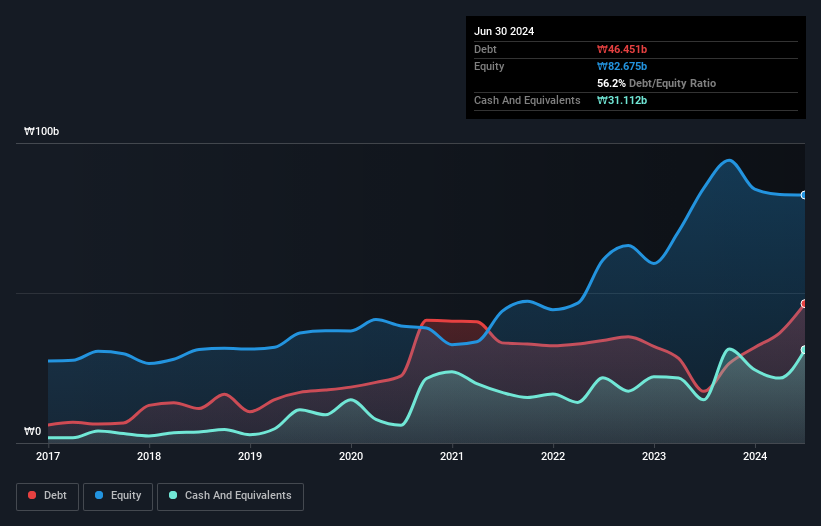David Iben put it well when he said, 'Volatility is not a risk we care about. What we care about is avoiding the permanent loss of capital.' So it might be obvious that you need to consider debt, when you think about how risky any given stock is, because too much debt can sink a company. We can see that DRTECH Corporation (KOSDAQ:214680) does use debt in its business. But the real question is whether this debt is making the company risky.
Why Does Debt Bring Risk?
Debt is a tool to help businesses grow, but if a business is incapable of paying off its lenders, then it exists at their mercy. Ultimately, if the company can't fulfill its legal obligations to repay debt, shareholders could walk away with nothing. While that is not too common, we often do see indebted companies permanently diluting shareholders because lenders force them to raise capital at a distressed price. Having said that, the most common situation is where a company manages its debt reasonably well - and to its own advantage. When we think about a company's use of debt, we first look at cash and debt together.
View our latest analysis for DRTECH
How Much Debt Does DRTECH Carry?
As you can see below, at the end of June 2024, DRTECH had ₩46.5b of debt, up from ₩17.2b a year ago. Click the image for more detail. However, it also had ₩31.1b in cash, and so its net debt is ₩15.3b.

A Look At DRTECH's Liabilities
Zooming in on the latest balance sheet data, we can see that DRTECH had liabilities of ₩36.8b due within 12 months and liabilities of ₩59.6b due beyond that. On the other hand, it had cash of ₩31.1b and ₩36.0b worth of receivables due within a year. So it has liabilities totalling ₩29.4b more than its cash and near-term receivables, combined.
Since publicly traded DRTECH shares are worth a total of ₩201.3b, it seems unlikely that this level of liabilities would be a major threat. However, we do think it is worth keeping an eye on its balance sheet strength, as it may change over time. The balance sheet is clearly the area to focus on when you are analysing debt. But you can't view debt in total isolation; since DRTECH will need earnings to service that debt. So when considering debt, it's definitely worth looking at the earnings trend. Click here for an interactive snapshot.
In the last year DRTECH had a loss before interest and tax, and actually shrunk its revenue by 4.6%, to ₩90b. That's not what we would hope to see.
Caveat Emptor
Importantly, DRTECH had an earnings before interest and tax (EBIT) loss over the last year. To be specific the EBIT loss came in at ₩9.6b. Considering that alongside the liabilities mentioned above does not give us much confidence that company should be using so much debt. So we think its balance sheet is a little strained, though not beyond repair. However, it doesn't help that it burned through ₩23b of cash over the last year. So suffice it to say we consider the stock very risky. The balance sheet is clearly the area to focus on when you are analysing debt. But ultimately, every company can contain risks that exist outside of the balance sheet. These risks can be hard to spot. Every company has them, and we've spotted 2 warning signs for DRTECH (of which 1 shouldn't be ignored!) you should know about.
When all is said and done, sometimes its easier to focus on companies that don't even need debt. Readers can access a list of growth stocks with zero net debt 100% free, right now.
New: Manage All Your Stock Portfolios in One Place
We've created the ultimate portfolio companion for stock investors, and it's free.
• Connect an unlimited number of Portfolios and see your total in one currency
• Be alerted to new Warning Signs or Risks via email or mobile
• Track the Fair Value of your stocks
Have feedback on this article? Concerned about the content? Get in touch with us directly. Alternatively, email editorial-team (at) simplywallst.com.
This article by Simply Wall St is general in nature. We provide commentary based on historical data and analyst forecasts only using an unbiased methodology and our articles are not intended to be financial advice. It does not constitute a recommendation to buy or sell any stock, and does not take account of your objectives, or your financial situation. We aim to bring you long-term focused analysis driven by fundamental data. Note that our analysis may not factor in the latest price-sensitive company announcements or qualitative material. Simply Wall St has no position in any stocks mentioned.
About KOSDAQ:A214680
DRTECH
Develops and sells flat-panel X-ray detectors for digital radiography in South Korea and internationally.
Adequate balance sheet and slightly overvalued.
Market Insights
Community Narratives




